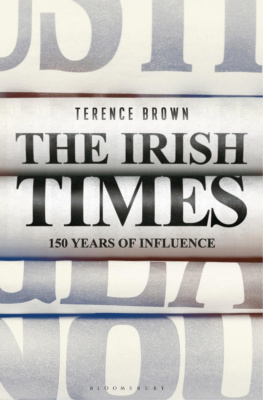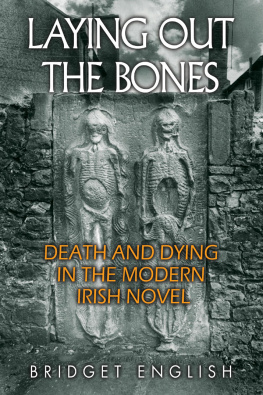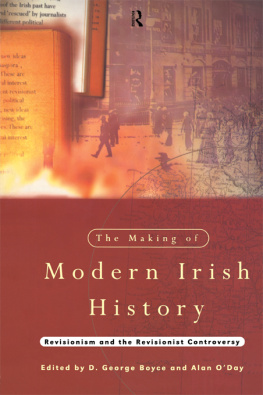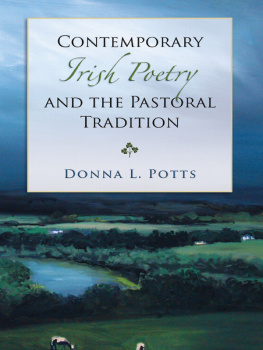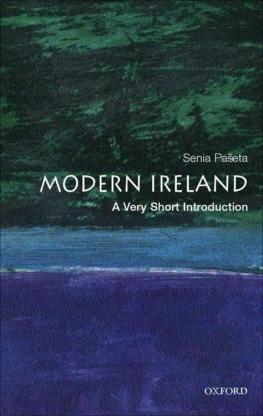The Judas kiss
Treason and betrayal in six modern Irish novels
Gerry Smyth
Manchester University Press
Copyright Gerry Smyth 2015
The right of Gerry Smyth to be identified as the author of this work has been asserted by him in accordance with the Copyright, Designs and Patents Act 1988.
Published by Manchester University Press
Altrincham Street, Manchester M1 7JA
www.manchesteruniversitypress.co.uk
British Library Cataloguing-in-Publication Data
A catalogue record for this book is available from the British Library
Library of Congress Cataloging-in-Publication Data applied for
ISBN 978 0 7190 8853 7 hardback
First published 2015
The publisher has no responsibility for the persistence or accuracy of URLs for any external or third-party internet websites referred to in this book, and does not guarantee that any content on such websites is, or will remain, accurate or appropriate.
Typeset by Out of House Publishing
For my friend and colleague Jo Croft
Historical revisionists are now convinced
Judas is the only Irishman among the Twelve Apostles.
Certain local historians are incensed
Yet this new theory has a large following.
Some revisionists say Judas was born in Cork
Others say he was a Dublinman
Others still insist he came from Kerry,
A cute hoor whod steal the salt out of the holy water.
After all that, I ask myself, who am I?
And then I wonder, does it matter a tinkers curse?
Am I you or Uncle Ted or Carney pilgrimming to Knock?
I know this morning I shall never die.
Because like God Im everywhere although
I think that I may settle in Foxrock.
Brendan Kennelly The Little Book of Judas, 69
Contents
James Joyces Ulysses (1922)
Liam OFlahertys The Informer (1925)
Elizabeth Bowens The Heat of the Day (1949)
Francis Stuarts Black List, Section H (1971)
Eugene McCabes Death and Nightingales (1992)
I have discussed various aspects of this book with a wide range of friends, family and colleagues over a long period of time. Of the many who have helped with comments and constructive criticism I would particularly like to thank the following: at Liverpool John Moores University Timothy Ashplant, Jill Drummond, Kevin Egerton, Elspeth Graham, Sonny Kandola, Lew Llewellyn, Frank McDonough, Tina McGeehan, Joe Moran, Glenda Norquay, Andrew Sherlock, Lucinda Thompson, Joe Yates and Andrew Young; Werner Huber and all the academic and administrative staff of the Department of English and American Studies at the University of Vienna, where I was Visiting Professor of Irish Studies between September 2010 and February 2011; colleagues from the international Irish Studies community Aidan Arrowsmith, John Brannigan, Scott Brewster, Christine Cusick, Caroline Elbay, Roberta Gefter, Derek Gladwin, Liam Harte, Keith Hopper, John McCourt, Eamon Maher, William Meier, Eugene OBrien, Noel OGrady, Michael Parker, Laura Pelaschiar, Lance Pettitt, Shaun Richards, Ian Campbell Ross, Richard Rankin Russell, Hedwig Schwall, Mark Traynor; Matthew Frost at Manchester University Press; David Lloyd and Jack Wilson Foster; facilitators for some of the public engagement work undertaken in relation to this book: Marie Augertin (London Irish Centre), Margot Power (Irish World Heritage Centre, Manchester) and Caroline Foulkes (London Irish Womens Centre); Chris Peters (Liverpool Picturehouse), Jake Roney (Liverpool Irish Festival) and Karen Wall (Irish Film Institute); for their unstinting hospitality and support, Jim and Jane Marshall; and my children, Kevin, Esther, Holly and Duncan.
Finally, and most of all, I thank my wife Stacey for her continuing love and support.
Supporting characters are, on the whole, credibly drawn,
The style simple but effective, the plot
Swings through various worlds, heavens and hells.
That grisly scene on the hill verges on
Melodrama but the aftermath has a joyous
Magic. I recommend a large paperback edition.
Ill bet it sells.
Brendan Kennelly, The Little Book of Judas, 213
In a speech in the United States in May 2012, the President of Ireland, Michael D. Higgins, spoke of the righteous anger that Irish people were feeling in light of the revelation that various institutions and individuals betrayed the trust placed in them (Marlowe 2012). What he was referring to on that occasion was the economic recession that had put paid to the Celtic Tiger more precisely, he was referring to the practices and attitudes that had precipitated Irelands calamitous fall from economic grace in 2008. Always a figure of suspicion to some, the Tiger had been exposed as a wantonly dangerous beast which thrived only by taking reckless chances with the lives of ordinary people. Hovering in the shadows of the Presidents speech, meantime, was the spectre of another high-profile modern Irish betrayal that of its constituents by the Catholic Church. By the second decade of the new century, in fact, the words Irish and betrayal had become closely linked one never too far from the other when questions of identity, meaning or value were at issue.
What does the emergence of betrayal as a prominent theme within modern Irish life signify?we must (unsurprisingly) turn to the past, or at least to the past as its imagined in various narrative discourses by which I mean those stories, related by itself and by others, through which a society learns about itself.
One such story is the Theme of the Traitor and the Hero (1944), in which the Argentinian writer Jorge Luis Borges imagines the mysterious death of a fictional nineteenth-century Irish revolutionary named Fergus Kilpatrick. A hundred years after his murder in a Dublin theatre, the circumstances surrounding this event begin to intrigue Kilpatricks great-grandson, a historian named Ryan. As he looks further into the case, certain parallels begin to emerge between Kilpatricks slaying and the assassination of Julius Caesar, as depicted in Shakespeares famous play. When Ryan delves deeper still, he also finds connections (some of them linguistic) with Macbeth.
Eventually the truth emerges: Kilpatrick was a traitor who, once his treachery had been exposed, agreed to participate in an elaborate theatrical performance designed to cement his own heroic profile and thus to expedite the revolution. Kilpatrick must be assassinated, and his martyrdom must become a rallying point for those whom he had betrayed. This performance was to be set across the whole of Dublin and was to involve large numbers of actors, including the central character, Kilpatrick himself, who embraces his role as doomed hero with alacrity. The man who came up with this plan, Kilpatricks lieutenant James Alexander Nolan, turned to the English dramatist Shakespeare to find effective scenarios and appropriate language with which to mount the show hence the echoes from two of his most famous tragedies. In Nolans work, the narrator writes,
the passages imitated from Shakespeare are the


